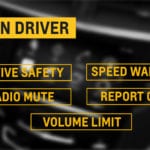As someone who grew up around car culture, I have personally experienced a lot of things many people only see in street racing movies and anime. That meant that when I got my driver’s license, I understood a lot of small driving details that made my first time out on the road a lot less stressful. Not everyone has that opportunity, so here are some things I’ve learned the hard way that may be some of the more useful teen driver advice you will read.
Stages of a New Driver
From personal experience, I can say new drivers typically go through three stages. At first, everyone with sense tends to be scared, which is incredibly reasonable considering they are piloting two tons of metal around far faster than humans were meant to go in an unfamiliar environment. However, it is after most get past those original fears that the most dangerous stage tends to begin.
After driving becomes routine, many drivers with less than two years of experience will unconsciously start to think they are invincible. This leads to less than safe decision-making and more distracted driving. Driving is routine, but one must always remember that everything a brand new driver is rightfully afraid of never goes away.
The “invincible” stage tends to end either when a driver has their first large crash or after a few close calls. The most sensible new drivers skip over this entirely, but few people have that level of maturity that early on. In my case, sliding off the road backwards at 70 mph, across a field, between several trees, into a ditch, and through a fence put me past the invincible stage. That single hair-raising incident could have ended far worse, but at least in my case, at age 17, I wasn’t going to truly learn any way but the hard way, and no one was hurt.
Once a driver gets past, or hopefully leapfrogs, the invincible stage, they become what could be called a “civil” driver. Civil drivers navigate safely, without skittishness or ambivalence. The only difference between a “civil” driver and an “invincible” driver is that a civil driver recognizes the seriousness of driving, even though it is routine.
Truly, one doesn’t even need to stop having fun behind the wheel to reach civil driver status. Just maintain a margin of error. Do not assume that other drivers will behave predictably, don’t approach the limits of your vehicle’s grip in traffic or in unfamiliar situations, and always understand and stay within your own limits.

Weight Shifting Basics
As an experienced autocross racer, I have some tips for newer drivers in terms of car control. While these lessons were largely earned during practice and competition, they are just as useful when driving on the street in inclement weather or in emergency situations.
The basis of car control is controlling the weight of the vehicle. Accelerating, braking, and cornering all move the weight, and thus the tire grip, of the vehicle. Maintaining control of a vehicle largely depends on not piling too much weight on any pair of tires. Acceleration moves weight to the rear, braking moves weight to the front, and cornering does the same side-to-side. Tires lose traction and begin to slide uncontrollably when they either have too much load or so little load they are losing contact with the ground.
Acceleration Tips
Depending on which wheels are powered, a car will behave differently when accelerating. Most vehicles today are front-wheel drive, which means that the front wheels are used for both accelerating and turning the vehicle. In a front-wheel drive car, as weight moves to the rear while accelerating, the front tires have less and less grip. Essentially speaking, this means that the harder a front-wheel drive car is accelerating, the more it will want to go straight, as the front tires will lack the grip to turn. This weight shift also means that front-wheel drive cars are very easy to break traction when accelerating, as when they accelerate, they have less grip.
The positive side to front-wheel drive vehicles is that they are the easiest to drive, as to gain more grip in most circumstances – all one has to do is get off the accelerator. During performance or emergency driving, using the brake to shift additional weight to the front can aid cornering ability, as long as one doesn’t overload the front tires.
On rear-wheel drive cars, acceleration actually applies more weight, and thus grip, to the driven wheels. That said, the tires can still be overloaded. When driving a rear-wheel drive vehicle, be cautious of hard acceleration, as letting off the gas will not automatically stabilize the vehicle like it generally does with a front-wheel drive vehicle.
All-wheel drive vehicles have a mix of these attributes, and depending on the vehicle and conditions, can behave like either or even both of the other drivetrain layouts under acceleration.
Braking Tips
Being able to stop in a hurry is the most important aspect of car control around town. On modern vehicles, this is actually quite simple, as stability control and anti-lock brakes will keep a vehicle on the straight and narrow even under heavy emergency braking. If one is driving a vehicle more than a decade old, however, some skill is required to haul it to a stop in an emergency.
Cars and trucks with older anti-lock braking systems (ABS), or no ABS at all, will require the driver to modulate the amount of force they apply to the brake pedal, taking care to apply pressure without overloading and locking up the front tires. In racing circles, this kind of braking is called threshold braking, and in some circumstances will actually stop a vehicle in less distance than any ABS system, provided the driver has practiced and mastered the technique.
That said, on unfamiliar or sketchy road surfaces, ABS-equipped vehicles are still safer, even for professional drivers. If your car has ABS and you need to stop in a hurry, don’t worry about locking up the brakes and push the pedal as hard as you can – the number one mistake drivers make in an emergency is not pushing the brakes hard enough.
Cornering Tips
Unlike straight-line acceleration and braking, cornering can move the weight of a vehicle in two dimensions instead of just one. While simply turning left or right will shift the weight and grip of a vehicle to the outside of said turn, things gain complexity when accelerating or braking while cornering.
From the perspective of the tires, accelerating or braking while turning is the most stress they could be put under. In dramatically oversimplified terms, if you need the maximum performance of your vehicle in any one area, it’s best only to do that one thing. Attempting to accelerate and turn at the same time in a front-wheel drive car could result in you simply torpedoing straight ahead in a cloud of tire smoke, while doing the same in a rear-wheel drive car could result in you pointed the opposite direction in a cloud of tire smoke.
It is true in every case that a driver shouldn’t overload their tires by asking too much of them, but there are some circumstances where advanced drivers can get more from a vehicle by shifting weight to the front or rear via acceleration or braking in small amounts, gaining more overall grip by changing the car’s balance through shifting the weight.
Learn Your Car and Understand Your Skill Level
Driving safely is a combination of driving within the limits of yourself and your vehicle, and car control is about maintaining balance through weight shifting. In every circumstance, keep a level head and make sure you know your limits beforehand. Driving isn’t only necessary to live life, but it can be fun as well. If not taken seriously, even a routine drive can end very badly. But if one keeps their wits about them, even in an emergency, things will turn out just fine.





